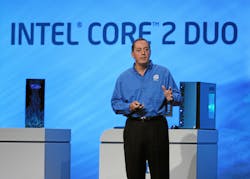Paul Otellini, who lacked the engineering talent that traditionally occupied Intel's chief executive role, but who ushered the world's largest chipmaker into a period of prosperity that lasted even as Intel missed the smartphone revolution, has died at the age of 66.
Intel issued a statement Tuesday saying that Otellini had passed away in his sleep. The company did not state the cause of death.
After three years as chief operating officer, Otellini served as chief executive from 2005 to 2013. Hired by Intel in 1974, he served as chief of staff for another former Intel chief executive Andy Grove in 1989 and later held the executive vice president role in the firm's architecture group.
Otellini's term was marked by Intel's success in personal computer and server sales. Intel’s sales were $53 billion in 2012, up from $34 billion in 2004. The growth was not possible without calculated sacrifices, and Otellini ordered in 2006 what was then Intel’s largest round of layoffs – 10,500 employees or 10% of the workforce.
“We are deeply saddened by Paul’s passing,” said Brian Krzanich, who was appointed Otellini’s successor in 2013. “He was the relentless voice of the customer in a sea of engineers, and he taught us that we only win when we put the customer first.” Otellini was Intel's first chief executive without an engineering background.
In addition to staying profitable during the financial crisis, Intel also started supplying chips for Apple's personal computers under Otellini’s watch. But shortly afterwards, Otellini missed out on supplying chips for the iPhone after a miscalculation of the market potential and the cost of making smartphone chips.
"We ended up not winning it or passing on it, depending on how you want to view it. And the world would have been a lot different if we'd done it," Otellini told The Atlantic in 2013. “The thing you have to remember is that this was before the iPhone was introduced and no one knew what the iPhone would do.”
Former colleagues have said that his management style was marked by an understated drive and dedication. "He didn't yell and scream. He never dictated. He never asked me to come in on a Sunday. He never asked me to stay late on a Friday," said Navin Shenoy, now executive vice president of Intel’s data center group, told The Atlantic.
"But he had this way of getting you to rise to the occasion," Shenoy added.
Otellini was born in San Francisco, California on October 12, 1950. He earned an economics degree from the University of San Francisco in 1972 and a business degree from the University of California, Berkeley in 1974. He is survived by his wife Sandy, son Patrick, and daughter Alexis.
About the Author
James Morra
Senior Editor
James Morra is the senior editor for Electronic Design, covering the semiconductor industry and new technology trends, with a focus on power electronics and power management. He also reports on the business behind electrical engineering, including the electronics supply chain. He joined Electronic Design in 2015 and is based in Chicago, Illinois.

